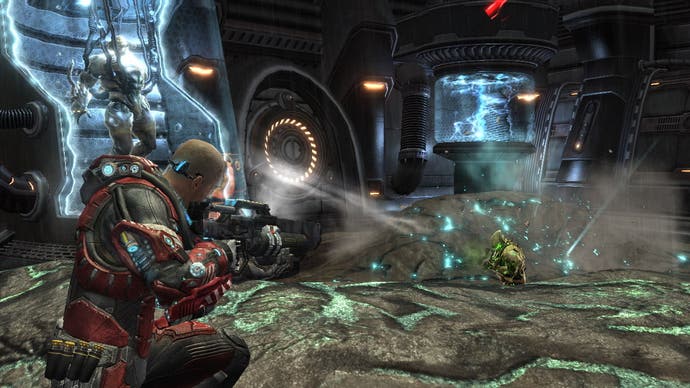Fracture
Painful.
Graphically the game is repetitious and bland, and everyone walking past my desk inquired whether it was an Unreal Engine 3 game - not a criticism of Epic's ubiquitous technology base, but an obvious sign that there's little at any given point that we haven't seen before. The most unusual thing about the visual design is that all your enemies appear to have been clad in gold foil, conjuring images of C-3PO Arbiters, while pretty much all the environments are gunmetal greys, muddy browns and mossy greens spread across deformable basins, through caves and over prefabbed military and industrial facilities that could be from Halo, Resistance or any other recent shooter you care to mention. The quality of Michael Giacchino and colleagues' expressive, rousing score is in sharp contrast to what's being thrown through the frame buffer.
There are a few good moments, but there's nothing particularly innovative. The vortex grenade, which swirls and gathers everything in its vicinity, including rocks, crates, enemies and pickups, eventually levelling out and distributing its victims face-down across a wide area, has been done before (as long ago as Quake mod Painkeep's Gravity Well, to pluck the oldest one from our collective memory), and an epic encounter with a skyscraper-sized walking dreadnought is sullied by the memory of much better equivalents in games like Halo 3.
Meanwhile, the game's Americocentric post-climate change story about conflicting biological philosophies is drowned out by a functional script, bland characters and conveyor belt scenarios (one of which centres around an actual conveyor belt), and there's nothing to like about the chap whose shoulder you spend the game looking over (especially his name - Jet Brody, for goodness sake). Set-piece moments pepper the arc, like the destruction of a familiar San Franciscan landmark a third of the way through, but these are immediately drowned out by the descent into another clichéd game of assault the genre staple facility, and while checkpointing is usually fair, irritating enemy design (hopping, jetpack-equipped rocket-launcher types, for instance, or burrowing mini Corpsers) and the game's other faults compensate by elevating the frustration levels.

Away from the campaign, Fracture supports 12 players across a range of familiar modes, the one exception coming in Excavation, which is a team-based game of capturing and holding territory by erecting and then protecting a spike. With a middling array of weapons, second-best mechanics and the same issues as in single-player conspiring to distract you from terrain deformation abilities, however, there's nothing here that will encourage you to come back as often as better shooters like Gears of War, Halo 3 and Call of Duty 4, and nothing structurally interesting to note, save perhaps the perfunctoriness of the 360 Achievements, which reward 50 games completed in various game-types and 10, 100, 250, 500 and 1500 multiplayer games endured. We pity the people who care about this stuff enough to bother.
We get through a lot of third-person shooters in a year, and our tolerance inevitably drops, so it's worth acknowledging that many of the vast list of things we object to in Fracture equal the low standard set by the likes of Turok and Haze, and that if you managed to survive those games without burning down the shop that sold them to you, this will suffice for a weekend's distraction. But with the vastly superior Gears of War 2 just weeks away from release, and even Dark Sector delivering an order of magnitude more innovation and class, there's little reason to celebrate a game that fumbles the basics of this generation's most prominent copy-and-paste genre and almost singularly flops with everything else it attempts.


